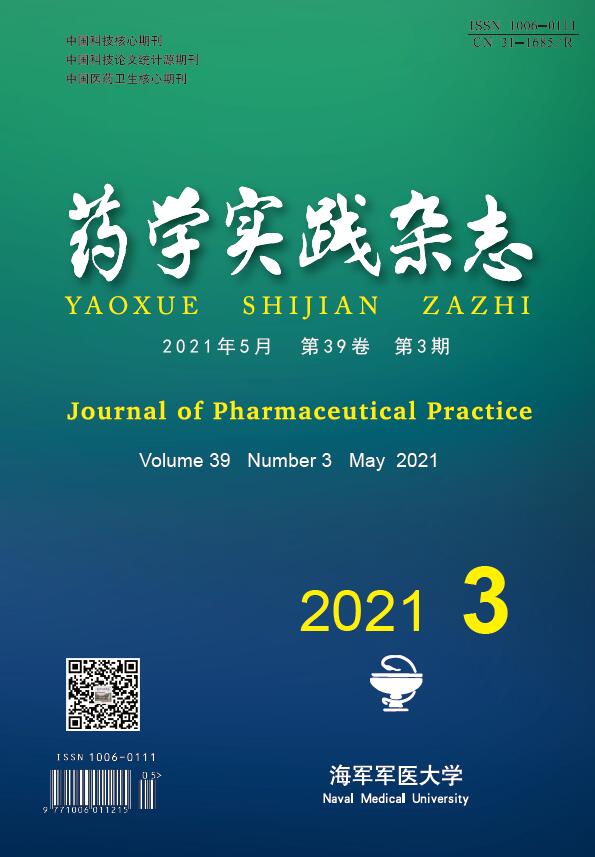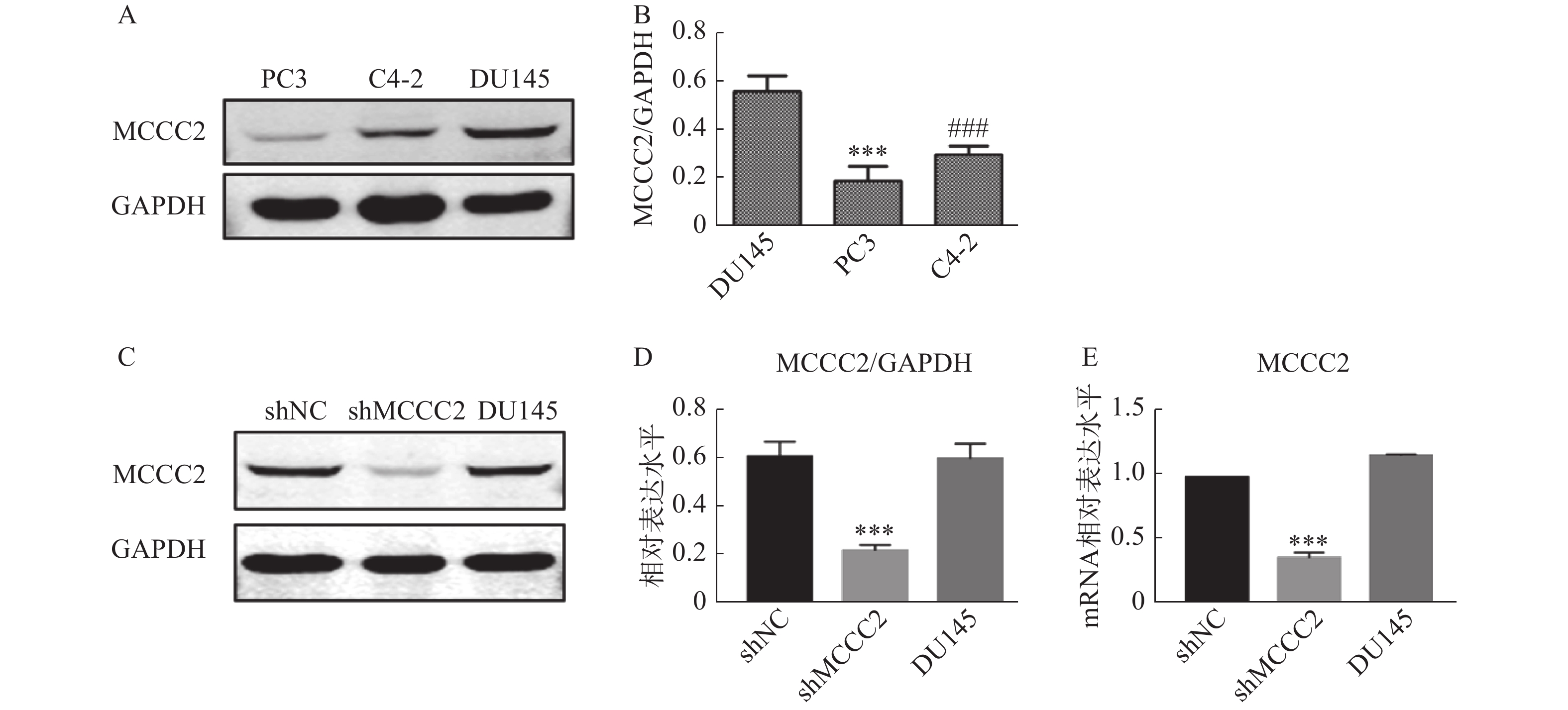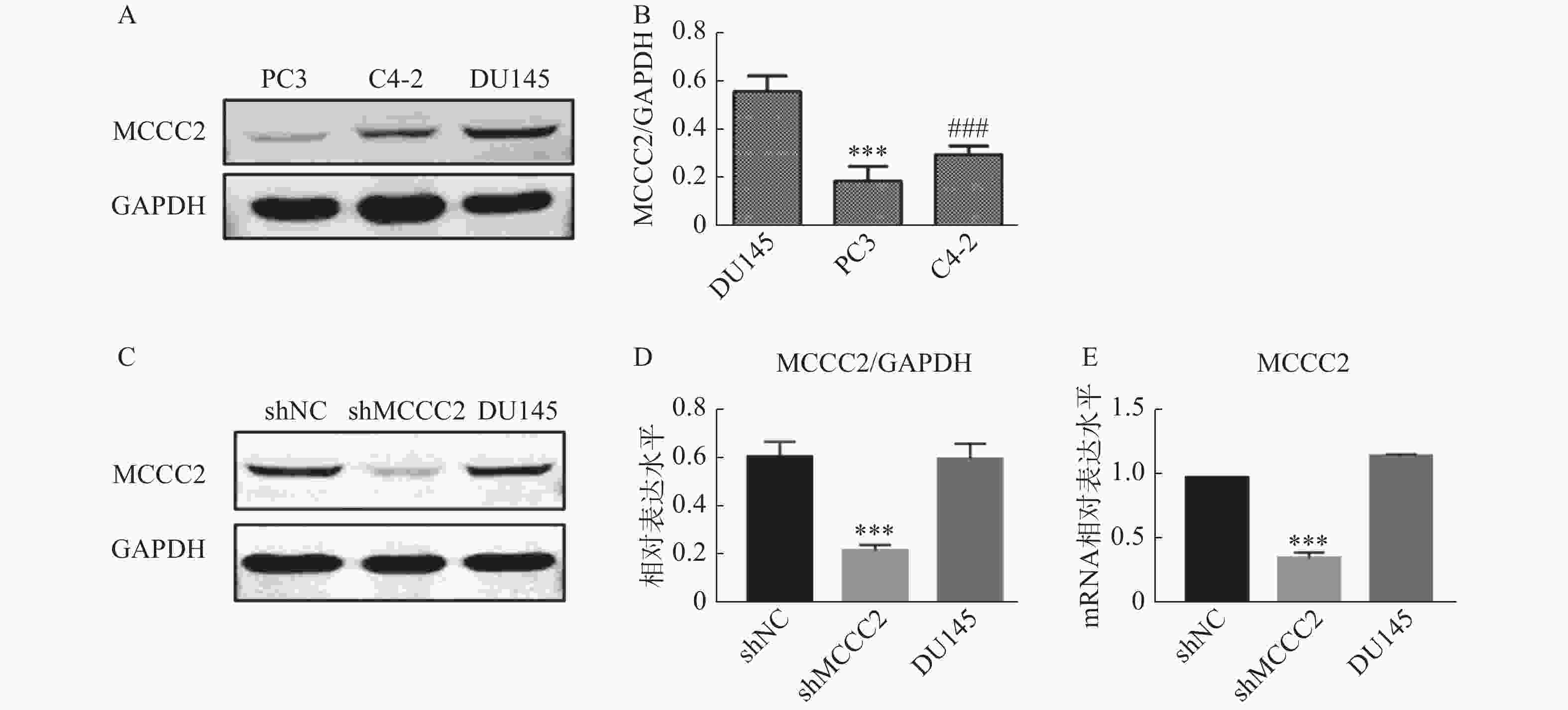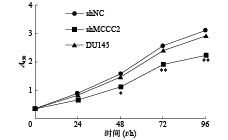-
前列腺癌(prostate cancer,PCa)是全球范围内第二位最常见的男性癌症,也是全球第二大致死癌症[1]。据统计,我国前列腺癌的发病率呈逐年上升的趋势,其中,上海地区该病的发病率和病死率较高,但总体而言,亚洲国家前列腺癌的发病率明显低于西方国家[1-3]。在前列腺癌的治疗中,局限性前列腺癌常规行根治性前列腺切除术或放射治疗,而对于进展期患者则需要接受内分泌治疗即雄激素阻断治疗(androgen deprivation therapy,ADT)。虽然ADT在早期可以明显抑制激素依赖性前列腺癌的进展,但是随着治疗时间的延长,激素依赖性前列腺癌会逐渐失去对ADT的反应而转化成为去势抵抗性前列腺癌(castration-resistant prostate cancer, CRPC),目前对CRPC尚无有效的治疗方法。因此,亟需深入挖掘CRPC病程进展中的关键基因和蛋白,为CRPC提供潜在治疗靶标。
Abula等[4]进行了PCa蛋白质组学文献的数据挖掘,发现了前列腺肿瘤组织和正常组织中41种差异表达蛋白,并构建了蛋白相互作用网络。其中,3-甲基巴豆酰辅酶A羧化酶β亚基(3-methylcrotonyl-coenzyme A carboxylase β subunit,MCCB)就是其中的重要差异蛋白之一。MCCB是生物素依赖性羧化酶(3-methylcrotonyl-coenzyme A carboxylase,MCC)的两个组成亚基之一,由563个氨基酸组成[5-8],MCCC2是该蛋白的编码基因。已有研究报道,MCCC2是一种致癌基因,与包括肝细胞癌、结直肠癌以及乳腺癌在内的多种肿瘤的形成和发展密切相关[9-11],有望成为肿瘤治疗干预的潜在靶标。
在本研究中,我们主要探讨了MCCC2与前列腺癌的关系。首先,采用慢病毒与质粒构建了稳定低表达MCCC2的DU145细胞株并通过Western blot和qPCR分析敲减率;然后,系统考察敲减MCCC2对DU145前列腺癌细胞的增殖、迁移以及凋亡的影响,明确下调MCCC2与DU145细胞系肿瘤生物学特性的改变的相关性。
HTML
-
人前列腺癌DU145细胞,来源于海军军医大学附属长海医院泌尿外科,培养于含10%胎牛血清的RPMI 1640培养基中。
-
CCK-8试剂盒(上海翊圣生物科技有限公司);兔MCCC2多克隆抗体、GAPDH抗体以及HRP标记山羊抗兔二抗(美国CST公司);4%多聚甲醛固定液以及结晶紫染色液(碧云天生物技术有限公司);细胞凋亡试剂盒(南京凯基生物有限公司)。
1.1. 细胞株
1.2. 材料与试剂
-
DU145细胞复苏后接种于含10%灭活的胎牛血清,100 U/ml青霉素和100 μg/ml链霉素的DMEM培养液中,置于37 ℃,5% CO2细胞培养箱中生长,每隔3 d传代一次。将shRNA质粒复合物加到含有细胞和培养基的培养板的孔中,来回轻柔摇晃细胞培养皿。细胞在CO2培养箱中37 ℃孵育24 ~ 48 h进行转染;再用嘌呤霉素筛选低表达MCCC2-DU145的稳定细胞株。
-
将复苏的细胞接种于大的培养皿中。3 d后细胞以3×103个/孔,接种于96孔板。分别在0、24、48、72、96 h后,加CCK-8试剂,在450 nm处测定A值,根据A值分析结果。
-
取出DU145细胞、NC-DU145细胞以及shMCCC2-DU145细胞,弃掉上清,加入PBS缓冲液洗3次,每次1 ml;加入细胞裂解液(Western及IP细胞裂解液∶PMSF = 100∶1),吹打细胞,置冰上裂解20 min;收集细胞裂解液于1.5 ml的EP管中,4 ℃,12000 r/min,离心15 min;上清液即为提取的细胞总蛋白溶液,可用于BCA法定量;加入5 ×蛋白加样缓冲液,沸水中煮5 min,于−20 ℃保存,可用于后续的Western blot实验。
-
配胶,捡漏,加入样品,先将电压调为80 V,待marker条带分离后,将电压调制120 V,直到蛋白样品跑至凝胶底部,停止电泳;恒流250 mA,冰浴90 min的条件下转膜;染色,封闭,再孵育MCCC2抗体以及二抗,置于Tanon5200光密度扫描仪中进行拍照;用Image J 灰度分析差异性蛋白条带。
-
将复苏的细胞接种于培养皿中,待对数生长期时,细胞以5 × 105个/孔接种于6孔板中,在37 ℃,5% CO2的恒温培养箱中孵育;48 h后,将培养基吸掉,加入PBS洗涤3次,每次1 ml;加入RA2裂解液,每孔500 μl,置于冰上1 min;将裂解液收集于内套管中,在12000 r/min下离心1 min;取出,将外套管中的液体倒去,向内套管中加入500 μl洗液,在12000 r/min下离心1 min;重复上述步骤一次;重复上述步骤,但是这次不加洗液,在12000 r/min下离心1 min;取出,弃去外套管,将内套管移入新的1.5 ml Ep管中,加入30 μl的洗脱液,室温静置2 min,在12000 r/min下离心1 min;得到总的RNA,并测定其浓度。
-
按照1 000 μg逆转录,总反应体系为20 μl。反应条件为:37 ℃,15 min;85 ℃,30 s;4 ℃,永恒。反应体系见表1。
-
反应条件:94 ℃预变性30 s后94 ℃ 10 s,60 ℃ 30 s,共进行40个循环后,进行溶解曲线的检测。反应体系见表2。
物质 加入量(V/μl) 总RNA X(X=1000/c,c为上述测定的总RNA的浓度) Rnase Free dH2O 16-X 5×Mix 4 物质 加入量(V/μl) cDNA 1.0 Primer R 0.3 Primer F 0.3 ddH2O 3.4 SYBR 5.0 总计 10 -
进行Transwell实验以评估细胞在体外的迁移能力。细胞用磷酸缓冲盐水(PBS)洗涤2次,用胰蛋白酶消化,稀释为每毫升含1 × 106个细胞,在Transwell室中,加入200 μl含1% FBS培养基的细胞液,下层用600 μl含10% FBS培养基处理。置于37 ℃、5% CO2的恒温培养箱中培养48 h,然后用棉签小心地擦去未穿过小孔的细胞,再用4%多聚甲醛固定30 min,最后用结晶紫染色1 h。使用倒置显微镜拍摄细胞照片,Image-Pro Plus 6.0分析实验结果。
-
将细胞以5 × 105/孔的比例接种于6孔板中,37 ℃孵育48 h。使用Annexin V-APC/7-AAD凋亡检测试剂盒,按照说明书操作方法,使用流式细胞术检测细胞凋亡。
-
数据分析通过SPSS (21.0)统计软件进行,采用单因素方差分析,实验结果用(
$\bar x$ ± s)表示。与对照组比较,P < 0.05,则认为差异具有统计学意义。
2.1. 细胞培养及转染
2.2. 细胞增殖实验
2.3. 细胞总蛋白提取
2.4. Western blot
2.5. 细胞RNA提取
2.6. cDNA的制备
2.7. RT-qPCR
2.8. Transwell迁移实验
2.9. 细胞凋亡实验
2.10. 数据分析
-
通过Western blot检测PC3、C4-2和DU145细胞中MCCC2的表达水平。如图1A和图1B所示,MCCC2在DU145细胞中的表达为(0.56 ± 0.05);MCCC2在PC3细胞中的表达为(0.24 ± 0.04);MCCC2在C4-2细胞中的表达为(0.32 ± 0.04)。结果表明MCCC2在DU145细胞中的表达水平高于C4-2和PC3细胞。为了探讨MCCC2在前列腺癌发生发展中的生物学作用,我们在DU145细胞中通过慢病毒转染稳定下调了MCCC2的表达。成功建立了低表达MCCC2的DU145细胞株,如图1C和1D,Western blot结果表明,shMCCC2组的MCCC2表达水平明显低于shNC组(0.22 ± 0.02 对 0.61 ± 0.06,P < 0.001),而DU145组与shNC组无明显差异(0.60 ± 0.06 对 0.61 ± 0.06,P > 0.05)。qPCR结果表明,shMCCC2组的MCCC2表达水平明显低于shNC组(0.36 ± 0.04 对 1.0 ±0.00,P < 0.001),而DU145组与shNC组无明显差异(1.17 ± 0.01对1.0 ± 0.00,P > 0.05,图1E)。
-
采用CCK-8检测敲减MCCC2对细胞活力的影响。分别在0、24、48、72、96 h后,加CCK-8试剂,在450 nm处测定A值,检测细胞增殖情况。如图2所示,48 h时,shMCCC2组的增殖明显低于shNC组(1.16 ± 0.03 对 1.59 ± 0.07,P < 0.05),而DU145组与shNC组比较无明显差异(1.47 ± 0.05 对 1.59 ± 0.07,P > 0.05)。在72 h时,shMCCC2组的增殖明显低于shNC组(1.92 ± 0.03 对 2.57 ± 0.08,P < 0.01),而DU145组与shNC组比较无明显差异(2.43 ± 0.11对2.57 ± 0.08,P > 0.05)。在96 h时,shMCCC2组的增殖明显低于shNC组(2.24 ±0.04对3.13 ± 0.15,P < 0.01),而DU145组与shNC组比较无明显差异(2.93 ± 0.05对3.13 ± 0.15,P > 0.05)。由结果可以看出,敲减MCCC2能显著抑制细胞增殖,并呈时间依赖性。
-
我们采用Transwell小室实验法测定敲减MCCC2对细胞迁移的影响。采用Image-Pro Plus 6.0分析实验结果,计算细胞迁移率。如图3A和3B所示,shMCCC2组的跨膜DU145细胞数量明显少于shNC组(23.96 ± 1.85对49.73 ± 0.63,P < 0.001);而空白对照组与shNC组相比,跨膜DU145细胞数无显著性差异(48.45 ± 1.26对49.73 ± 0.63,P > 0.05))。由此可见,敲减MCCC2可有效抑制前列腺癌细胞的迁移。
-
进一步利用Annexin V-APC/7-AAD凋亡检测试剂盒检测了敲减MCCC2对DU145细胞凋亡的影响。结果如图4A和4B所示,shMCCC2组DU145细胞的凋亡率明显高于shNC组(12.64 ± 0.30对 3.68±0.02,P<0.001);空白对照组与shNC组相比,DU145细胞的凋亡率无显著性差异(5.30 ± 0.02对3.68±0.02,P>0.05)。因此,敲减MCCC2可诱导DU145前列腺癌细胞凋亡。
3.1. 建立MCCC2低表达DU145细胞株
3.2. 敲减MCCC2对DU145细胞生长的影响
3.3. 敲减MCCC2对DU145细胞迁移的影响
3.4. 敲减MCCC2对细胞凋亡的影响
-
围绕CRPC发生发展中的关键基因和蛋白,已有研究者采用蛋白组学和转录组学等多种组学技术深入挖掘PCa中AR等重要信号通路的关键调节蛋白、基因和潜在的疾病标志物,发现MCCB是前列腺肿瘤组织和正常组织中差异表达的关键蛋白之一[4],而编码该蛋白的基因MCCC2为AR信号通路调节的关键基因,在人类前列腺癌临床样本中显著过表达,可作为潜在的肿瘤标志物[10]。
3-甲基巴豆酰基辅酶A羧化酶(MCC)是一种生物素依赖的羧化酶,可将3-甲基巴豆酰基辅酶A催化为3-甲基戊二酰辅酶A[5-6],是亮氨酸降解途径的重要一步。MCC包含α(MCCA)和β(MCCB)两个亚基,分别由MCCC1和MCCC2基因编码[12-13]。MCC在人体内主要表达于肾脏和肝脏中,它的缺陷可引起甲基巴豆酰甘氨酸尿症,严重的可导致婴儿期的死亡[14-16]。MCC缺陷主要与MCCC1和MCCC2基因的突变有关[17-21]。人MCCC1位于染色体区域3q25-q27,具有19个外显子,而MCCC2位于染色体区域5q12-q13,由17个外显子组成[7-8]。迄今为止,人类基因突变数据库中共报道了MCCC1基因的49个突变和MCCC2基因的52个突变[22]。近年来,越来越多的研究表明,MCCC2参与了包括肝细胞癌、结直肠癌以及乳腺癌在内等多种肿瘤的形成和发展[9-11],其在不同肿瘤中发挥的重要作用有待进一步挖掘。
本研究主要探究了MCCC2与前列腺癌的关系。结果表明,敲减MCCC2可显著抑制DU145前列腺癌细胞的增殖和迁移,并诱导细胞凋亡。研究结果提示,MCCC2可能在前列腺癌发生发展过程中发挥重要作用,有望成为治疗前列腺癌的一个潜在新靶标。至今尚无针对其编码蛋白MCCB的选择性抑制剂的报道,是前列腺癌治疗药物发现的潜在新方向。













 DownLoad:
DownLoad:


